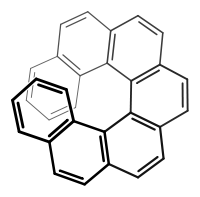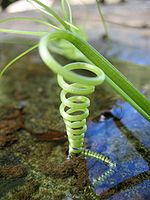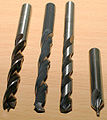Helix
The helix (from Greek έλιξ “curved, bent”; plural helices or helices ), also called screw , helix , cylindrical spiral or helix , is a curve that winds around the jacket of a cylinder with a constant gradient .
Winding direction
The naming of the winding ( helicity ) follows the thumb rule rights , the helix is right-handed when they are in the clockwise winds (viewed in the direction in which they are from the viewer away ), otherwise left-handed.
In botany, plants are viewed from above; H. viewed against the direction of growth. In contrast to the above general definition is the object of observation so the viewer to . Therefore z. B. called as right-handed helix growing plants left-winding because they turn counterclockwise when viewed from above .

Mathematical description
The vectorial description of a helix in Cartesian coordinates is:
- Here is the number of turns passed through by.
- Here, the pitch , so that route, the screw around in a complete revolution upward (in the direction of the cylinder axis; z-direction) overcomes the radius and the displacement of the screw in the z direction.
- is the pitch of the helix: the helix is a straight line with slope when the cylinder mantle with the helix in the plane handles .
- The helix is called the pitch angle .
Pitch and pitch are two fundamental parameters in the technical applications of the Helix, for example for the standardization of threads .
- properties
- For left-handed helices becomes negative.
- The arc length of the helix is calculated as follows:
- The curvature , the curvature radius (the second term is the curvature defect in relation to the wrapped cylinder) and the turn are constant .
- The twist means the measure of how strongly a wire is twisted in itself when one overcomes it into a helix.
The helix is a chiral curve because it can not be brought into congruence with its mirror image by rotating and shifting. For example, mirroring a screw with a right-hand thread results in a screw with a left-hand thread. And both are not congruent, neither in three-dimensional space nor as a two-dimensional image.
Multi-start screws
If you put two congruent helices together offset by half a pitch ( ), you get a two-start screw . The same result is obtained by shifting the second helix by half a turn. The two helices are then at a constant distance from each other and never touch, so the resulting curve splits into two branches. Analogous formation with several helices results in corresponding multi-thread helices . These definitions play an important role in technology.
Helix and spiral
With the central projection of a helix in the direction of the axis onto a flat surface, a hyperbolic spiral is created , in which the radius of the turns is constantly reduced so that they lie one inside the other in the plane. This corresponds to looking into a helix along the axis (see illustration of the double spiral staircase ), because the eye sees the central perspective .
Examples of helix shapes in nature and technology
Helices in nature and technology
- plant tendrils serve as anchoring,
- allow in limited space and with little material a strong spring action of the coil spring ,
- offer space savings by "winding up" the straight lines to form a cylinder (e.g. for telephone and extension cables),
- can be used as a compact mechanical force transducer , as used in the thread of screws .
Helical structures
Double spiral staircase in the Vatican Museum in Rome. The building is helical in shape - one staircase can be used as an entrance, the other as an exit, enabling good passenger traffic in a museum. The chirality of the double helix corresponds to a right-hand thread.
The screw rotation of this tendril corresponds initially to the direction of rotation of a left screw and changes the direction of rotation three times. The grown shape hardly deviates from the ideal helix in sections and clearly in others.
The best-known screw-like biopolymer is DNA , which is also known as a double helix because of the two complementary single strands of DNA that run around each other . Furthermore, subsections of many proteins, especially those that are integrated into biomembranes (integral proteins) , have a helical structure. This type of structure of the secondary structure is called an α-helix . Also, the per turn from about 6 α- D - glucose units constructed polysaccharide amylose , in addition to amylopectin in starch is included, the mold has a helix.
In chemistry there are hydrocarbons - the helicene - with a screw-like structure.
In technology, a helix is often a self- supporting helical wire component ( incandescent helix , helical antenna , wire resistor, helical tube cartridge). Another typical helix is the coil spring , which accommodates the spring forces of a long spring in a small space. The spiral staircase also makes use of the space savings because it only takes up a small area. The same applies to the spiral ramps in underground garages and multi-storey car parks . The wire of an incandescent lamp is often a double coil , i.e. a helix, around which another helix runs (for structure, see picture examples). Other examples are the outer edge of the auricle or the peptide chains made of collagen .
Coiled slides for people, for example in the Pyramidenkogel observation tower, have the advantage of increasing the contact pressure when the speed is increased by the centrifugal force. Similarly shaped chutes for letters and parcels are also called sorting augers.
Mixing nozzles for 2-component adhesives (or putty) often have cylindrical to conical helix inserts.
The double spiral staircase in Graz Castle consists of two interpenetrating spiral staircases, the screw directions of which are opposite and whose axes strut up next to each other.
In snack vending machines, which are visibly equipped with sugar sacks, candy bars, etc. behind a glass window, coils made of thick chrome-plated steel wire transport one requested item forwards to the drop in the ejection. For each thread turn one article is inserted at an angle in the screw, all subsequent articles are pushed one step forward along the bearing groove.
Screw and wedge effect
The wedge effect is based on the fact that the angle of inclination “translates” a movement along the long leg into a normal movement along the short leg (an inclined plane along a rod as a simple machine ). Due to the law of leverage , the resulting normal force is greater than the force used by the ratio of the legs. The smaller the angle of incline (the flatter the wedge), the stronger the effect.
The same applies to the Helix. Therefore, a relatively small torque around the central axis (small tangential force) can be converted into a large force along the axis. The thread of a screw with nut is based on this principle, as is that of the Archimedean screw and the screw conveyor . The functioning of the propeller or the threaded spindle in mechanical engineering is based on converting rotation into propulsion / feed . The adjustment screw uses conversely a reduction of the road, which makes a fine setting possible. Also corkscrew with and without "soul" are helically.
The flutes of drills are arranged helically around the drill jacket . Colloquially, the drills are incorrectly called twist drills .
The double wedge effect is created by conical screws: nail drills for soft wood, the wood screws common up until 1975, today the machine screws with hexagonal heads. Only thread extractors have a left-hand thread.
Roping
Another application is roping . While the breaking load for a single thread or a parallel fiber bundle only depends on the cross-section, and therefore the thickness and weight also increase significantly, the individual fibers or strands of a rope are twisted ("twisted"). When loaded, the tensile force creates a force normal to the fiber, which - because the pitch of the helices is close to 90 ° and the wedge effect is reversed - is significantly less per length of a diameter. In addition, it is transferred to the neighboring fibers and / or the core as compressive stress . The forces between the individual fibers or strands cancel each other out, the core is extremely compressed (therefore elastic materials are used for this) and absorbs the energy.
Ropes made exclusively by impact in one direction react to tensile load by a torque between the ends and this rotation is allowed by untwisting. This usually undesirable effect is countered by installing axially rotatable vortices - for example between the individual rope and crane hook, in guy ropes e.g. B. from overhead lines, Bowden cables, passenger lift cabins or mulfile fishing line. Untwisting or twisting moment is also generated when a rope runs under tension over an edge or pulley or a sewing thread is pulled through the eye of a needle. To avoid these phenomena as much as possible, a rope (or cable) is laid in both directions: The strands can be laid (in themselves) in one direction, but the strands to the rope in the other direction. Or layers of strands can be stranded in alternating lay directions. Twist-free ropes are the goal, for example to guide cable cars safely over idlers.
It is only when a rope is laid that it becomes cohesive over the circular cross-section and the failure of individual strands in places is eliminated. Ropes generated with stronger impact are softer when subjected to tensile loads.
In braided ropes, left and right twisted fiber bundles are intertwined with each other (woven around). Both core-sheath ropes, flat textile lifting loops constructed in the same way and many shoelaces have untwisted fiber bundles in the core, which in principle cannot create a twist.
There are cables for data transmission that are generated along their length (!) With alternating lay directions. At the (marked) reversal points, it is possible to loosen a piece of stranded wire on both sides in order to have it relaxed with a little extra length for processing a bit away from the cable.
Pipes and hoses
Ventilation pipes with a diameter of typically 20–60 cm are made from thin galvanized sheet steel by twisting and flanging . Thick-walled steel pipes for pipelines, district heating, as power plant pressure pipes with a diameter of 30 to 400 cm are manufactured by bending sheet metal into coils and butt welding.
Protective hose for the bathtub hand shower, for electrical cables for pivoting doors and windows, and swan necks are made from coiled sheet metal strips with an S-shaped profile. The displaceability between two adjacent turns of the helix results in the hose axis being able to be bent or stretched in the direction of this axis. There is pipe material made of multi-folded aluminum foil with a diameter of around 10 cm for smaller ventilation in apartments, which can only be bent and stretched once. (Bellows - joints on district heating pipes, vacuum technology - are thin-walled pipes that are made flexible and expandable with grooves without coiling.)
Cylindrical cardboard tubes as winding cores for toilet paper and carpeting, formwork for concrete columns or for fireworks are produced by endless winding.
Tight plastic hoses for vacuum cleaners become flexible through grooves in the jacket. In most cases, there is a coiled groove, which means that it can be screwed into connection pieces and the possibility of installing a wire helix to stabilize the tube carrying negative pressure in the lumen. (Grooved hose of the electrical installation is usually not coiled.)
Dust extractors on larger machines, suction hoses for sewer cleaning and fire brigades typically use hoses with an internal wire helix, possibly with a small rope constriction between its passages.
physics
In physics, an electrically charged particle that moves in a magnetic field follows a helical trajectory. The prerequisite is that the particle does not move parallel, anti-parallel or transverse to the north-south orientation of the magnetic field. The force that forces the particle onto this helical trajectory is called the Lorentz force . When moving parallel or antiparallel to the north-south orientation of the magnetic field, a straight flight path is created and when moving transversely to the north-south orientation of the magnetic field, a circular path is created. When an electrically charged particle emits energy through electromagnetic radiation on such a circular path, it moves on an increasingly narrow spiral path . The helical trajectory of the electrically charged particle is a superposition of a straight trajectory and a circular path. In the event of energy losses through electromagnetic radiation, and also in inhomogeneous magnetic fields, conical spirals arise from the superposition of screw and spiral.
Lanes
The figure of the screw - rotation around the longitudinal axis of the body - in water and parachute jumping or in jumping acrobatics causes points on the outside of the body to move along a helix, which can still be curved along a trajectory parabola.
The corresponding figure in aerobatics is called a role .
Every point on a projectile flying with a twist for stabilization creates a helix. If a sports bow and possibly a dart rotate, each wing tip describes a helix. Simple rockets can be stabilized in the propulsion phase by twisting around the longitudinal axis. If a satellite aligned with its own rotation orbits the earth, a point on its mantle only creates a helix very precisely if and as long as the current direction of flight points in the direction of the rotation vector.
Image examples
Helical cable (e.g. on the telephone )
Screw along a screw, double helix (e.g. filament lamp )
Helix structure in the facade of the Art Tower Mito
Right-hand helix of the real windlass , incline about 60 °
Left-handed helix of the common wormwood
Helically wound plasma core (yellow) of a stellarator , here the Wendelstein 7-X experimental fusion reactor
See also
Web links
- www.wissenschaft.de: Why nature loves the helix so much
- Frieda Nugel, Die Schraubenlinie, Dissertation University of Halle-Wittenberg 1912
Individual evidence
- ^ Marc Gingras, Guy Félix, Romain Peresutti: One hundred years of helicene chemistry. Part 2: stereoselective syntheses and chiral separations of carbohelicenes. In: Chemical Society Reviews. Volume 42, 2013, pp. 1007-1050, doi : 10.1039 / C2CS35111K .
- ^ Ars Electronica Festival in alter Post , ORF.at, May 13, 2015, last accessed August 10, 2016. - Picture of a series of sorting screws.
- ↑ Ventilation pipe on the r-hol sidewalk , flickr.com, December 5, 2010, accessed August 10, 2016.
- ↑ http://www.nwpipe.com/about-2/ Northwest Pipe Company, Vancouver WA, USA - Manufacturer of helical pipe with an outer diameter of 12–156 inches.
































